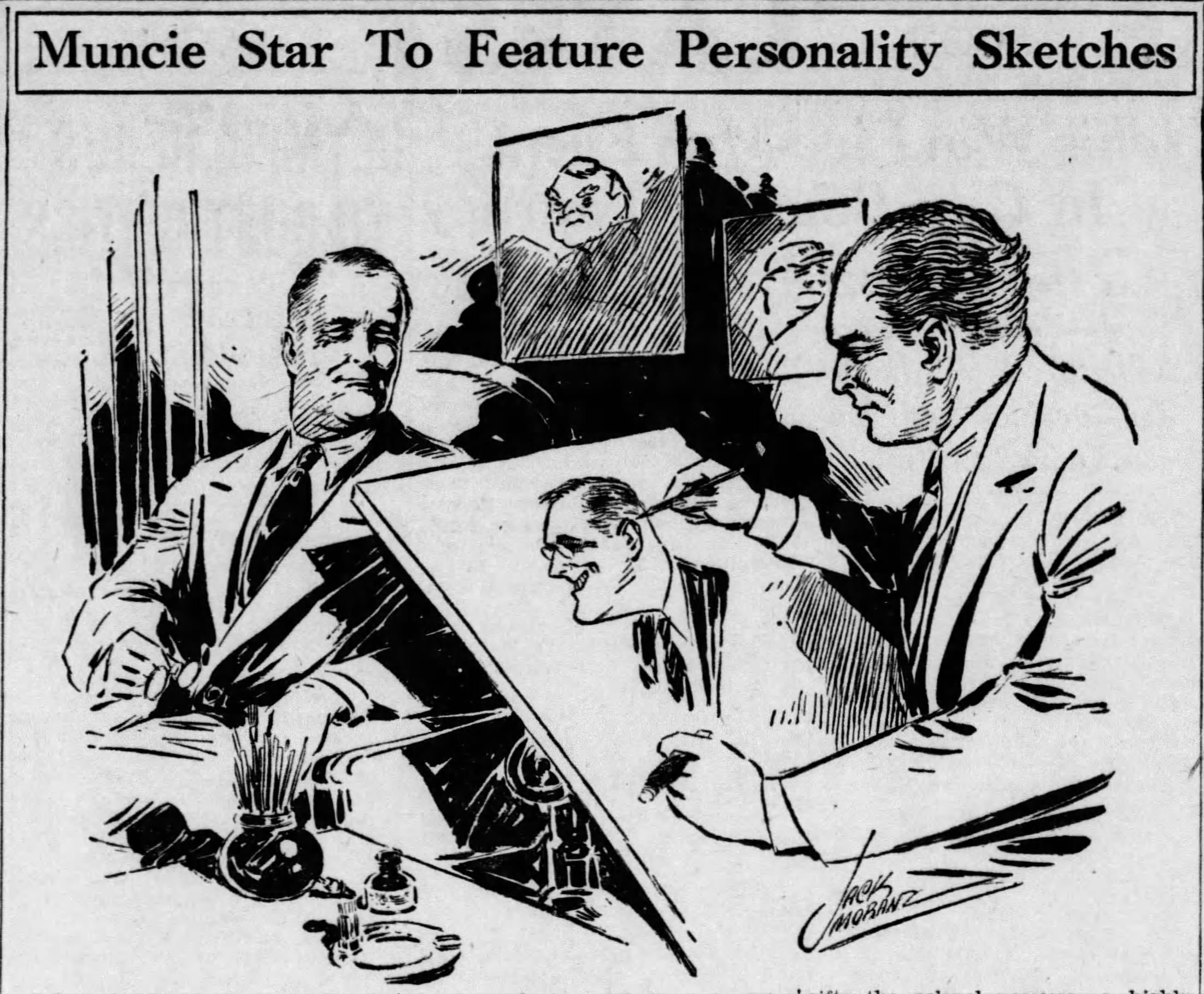Portraits and Personalities
How do you “get to know” celebrities, politicians, and your local “movers and shakers”? I know for me, one of the easiest and quickest ways to find out more is by looking at social media. Through tweets, Instagram posts, facebook pages, and even a TikTok or two, I not only catch glimpses into the work of these individuals, but I’m also able to get a peek at the hobbies and personalities of my mayor, news anchor, and local business owners. While today’s lifestyle of constantly being connected to a device certainly makes this easy, how about twenty, forty, or even eighty years ago? Even though communication methods may have been very different in the 1930s, citizens still craved an insider’s view of the lives of their community’s notable residents. In Muncie, the Star Press lent a hand. Through a special feature they not only highlighted some of Muncie’s lives lived, but they also did it in an eye-catching way.
Appearing in the March 2, 1936 issue of The Star, I. Elizabeth Cade (of Cade Company Florists) was the only woman highlighted in the “Muncie Personalities” series. Newspapers.com
In December of 1935, the Star Press announced to its readers that a new special feature was on its way. Beginning in January 1936 and stretching into March of that year, readers would find in each issue of the newspaper a cartoon portrait of a notable resident. Drawn by the hand of Jack Moranz, these pen and ink portraits were more than just a likeness. They provided insight into the personality of each subject, and carried a particular whimsical flair.
Born around 1900 in Ohio, by the 1930s Col. Jack Moranz was working as a cartoonist and illustrator for newspapers around the country. Although he was a veteran of World War I, a life in the military was not his calling. Instead he pieced together an art education in Chicago and Europe. His studies with internationally known illustrators and etchers like Georges Scott and Joseph Pennell paid off. In the 1920s, Moranz was part artist, part entertainer – taking to stages around the world to show off his skills drawing caricatures at lightning speed. He cut his teeth on newspaper work with the New York World, where he was brought on as an illustrator. By 1929 he had begun one of the most notable projects of his career. Working with newspapers all over the country between 1929 and 1938, Moranz provided short-run series of pen portraits highlighting notable citizens. The first to appear graced the pages of the local newspaper in New Castle, Pennsylvania. From there he undertook similar projects with papers all over the country. With his pen and wit, Moranz highlighted the lives of notable citizens from Los Angeles to New York, and just about everywhere in between.
This sketch by Jack Moranz appeared in the December 31, 1935 issue of The Star – promoting the upcoming “Muncie Personalities” series. The artist has captured himself drawing a portrait of President Franklin Delano Roosevelt. Newspapers.com
In 1936 Muncie had its turn. The first announcement of the illustration series featuring Muncie’s notables appeared in the December 30, 1935 issues of The Star. In addition to introducing the illustrator, Jack Moranz, the article also got at the heart of what the series was all about:
“Through the materializing genius of the artist, readers of ‘The Star’ will come to know better not alone the achievements of noted men, but the cause standing back of those victories; also all those intimate and interesting characteristics which lie hidden behind those twin veils of responsibility and power, but are the very warp and woof of human experience as it ripens into personality.”
Just eleven days later the first of the “Muncie Personalities” cartoons appeared – highlighting Lemuel Pittenger, president of Ball State Teacher’s College. Over the next two months fifty-two “Muncie Personalities” appeared on the pages of The Star. Ranging from educators to lawyers and local business owners to ministers. Under the creative hand of Moranz, readers found out that while Lemuel Pittenger’s hobby was farming, A.C. Thornburg’s (Thornburg Hotel Co.) was golf. And although H.D. Singer grew up to own Singer’s Bakery in Muncie, his childhood dream was to become a doctor.
George A. Ball’s likeness was featured in the January 15, 1936 issue of The Star. Moranz highlighted Ball’s interest in rare books, as well as his work at Ball Brother’s, and his philanthropic interests. Minnetrista Heritage Collection
Not surprisingly, amongst the over five dozen “Personalities” presented were members of the Ball family. George A. Ball was the first to appear – with a sketch touching on his love of old and rare books. In the following weeks, George’s brother, Frank C. Ball, and two of his nephews, Edmund F. Ball and Frank E. Ball were also featured in the series. But, how did Moranz, who was not a Muncie resident capture such good likenesses? How did he have such intimate details about their lives?
Jack Moranz was supplied with photos from Neiswanger Photography when preparing his “Muncie Personalities” series. Photos, like this one of Ed Ball, were used by the artist to transform some of Muncie’s notable citizens into lively cartoons. Minnetrista Heritage Collection
For the portraits themselves, Moranz was supplied with photographs of each of the fifty-two subjects in the series by Neiswanger Photo Studio in Muncie. With those photos in hand, Moranz could not only create the central pen portrait, but also caricatures of each subject in childhood, at work, or in other situations depicted in the cartoon. As for the short snippets of information regarding childhood ambitions, hobbies, first jobs, and current work, the subjects filled out and returned a questionnaire directly to the artist. In this way, each of the “Muncie Personalities” shaped their presentation to the public, and also had a hand in the creation of these unique and humanizing pen portraits.



